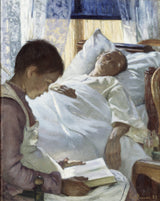Eva Bonnier, 1887 - Reflection in Blue - fine art print
Tax included. Shipping calculated at checkout.
Pick your product material variant
We offer a range of different materials and sizes for every product. The following options are available for individualization:
- The canvas print: The printed canvas mounted on a wooden frame. The great advantage of canvas prints is that they are relatively low in weight, which means that it is quite simple to hang the Canvas print without the support of additional wall-mounts. Therefore, canvas prints are suited for all kinds of walls.
- The poster print (canvas material): Our poster is a printed canvas with a fine finish on the surface. It is used for framing your art replica with a personal frame. Please keep in mind, that depending on the size of the poster we add a white margin of around 2-6cm round about the work of art, which facilitates the framing with your custom frame.
- Acrylic glass print (with real glass coating): An print on acrylic glass, which is often referenced as a fine art print on plexiglass, transforms an original work of art into brilliant décor. Besides, it makes a great alternative to canvas or aluminium dibond fine art prints. Your artwork is being custom-made with state-of-the-art UV print machines. It makes vivid and sharp color tones. With a glossy acrylic glass fine art print contrasts and color details become identifiable due to the very fine gradation in the print. Our real glass coating protects your custom art print against light and external influences for many decades.
- Aluminium dibond: These are metal prints on aluminium dibond with an outstanding depth effect. A direct Direct Print on Aluminum Dibond is your excellent start to the sophisticated world of fine art prints with aluminum. For the Direct Print On Aluminum Dibond, we print the chosen work of art on the aluminium composite white-primed surface.
Legal disclaimer: We try whatever we can to describe the art products in as much detail as possible and to demonstrate them visually. However, the pigments of the printed materials and the printing might differ slightly from the representation on your monitor. Depending on the screen settings and the nature of the surface, not all color pigments will be printed one hundret percent realistically. Given that all fine art prints are processed and printed manually, there might as well be minor deviations in the motif's exact position and the size.
Original information about the artwork by the museum's website (© - Nationalmuseum Stockholm - Nationalmuseum Stockholm)
English: Eva Bonnier’s depictions of terminal illness, bring us a pared-down everyday perspective, with the artist challenging the stereotypical female bourgeois ideal of the time. Women are presented as “subjects” with strong integrity and not as fragile objects. In Reflection in Blue, from 1887, the figures are painted from a realistic perspective, placing us in the same room as the ailing person. Around the turn of the 20th century, convalescing women are a popular theme in art. Those images should be seen in the context of the prevailing view of and construction of femininity, and thus of the standardisation of the female body. During the 19th century, two key images of women evolved: the weak, sensitive and psychosomatic upper class woman and the strong, dangerous and infectious lower class woman. The “Convalescent” became a symbol of female fragility and thus evidence of women’s inability to take part in public life. Those images can be seen as a reaction to the emancipation of women at the time and as an attempt to return them to the home and the private sphere. But in the Nordic region one could find many hundreds of female artists and authors during this period. The female artists in Sweden were privileged compared with their European sisters, since they had access to an academic education. The women’s department of the Royal Swedish Academy of Fine Arts in Stockholm opened in 1864, and the professional women had a major influence on the cultural life of the period. They changed both the view of the role of the artist and that of middle-class family life, and in so doing they shook the norm of the male artist to the core. But at the turn of the century there was a backlash and women’s emancipation was thwarted, together with a widespread fear of the “New Woman”. I Eva Bonniers sjukdomsbilder möter vi avskalade vardagsskildringar av kvinnor. Motiv där konstnären ifrågasätter tidens stereotypa kvinnlighetsideal. Kvinnorna är skildrade som subjekt med stark integritet och inte som bräckliga objekt. I Reflex i blått, som är från 1887, är figurerna gestaltade utifrån ett realistiskt perspektiv där vi som betraktare befinner oss i samma rum som den sjuke. Kring sekelskiftet 1900 var bilder av kvinnliga konvalescenter ett ofta förekommande motiv. Bilderna bör sättas i samband med konstruerandet av tidens syn på kvinnlighet och därmed med normeringen av kvinnokroppen. Under 1800-talet formades två viktiga bilder av kvinnan, den svaga, ömtåliga och sjukliga överklasskvinnan och den starka, farliga och smittsamma underklasskvinnan. Konvalescenten blir ett tecken för kvinnokönets bräcklighet och därmed ett bevis för kvinnans oförmåga att delta i det offentliga livet. Bilderna kan ses som en reaktion mot tidens kvinnofrigörelse och ett försök att återföra kvinnorna till hemmet och den privata sfären. Vid den här tiden fanns det enbart i Norden, tack vare den gryende kvinnofrigörelsen, många hundra kvinnliga konstnärer och författare. De kvinnliga konstnärerna i Sverige var privilegierade jämfört med sina europeiska systrar, eftersom de hade tillgång till akademiundervisning . Den Qvinliga afdelningen på Konstakademien i Stockholm öppnades redan 1864. De yrkesverksamma kvinnorna tog och fick mycket utrymme i det offentliga konstlivet. De förändrade tidens syn på både konstnärsrollen och det borgerliga familjelivet. De rubbade därmed den manliga konstnärsnormen som kom i gungning. På 1890-talet kom det en motreaktion, en backlash.
Product explanation
Reflection in Blue was painted by Eva Bonnier in 1887. The masterpiece was painted with the size of Height: 80 cm (31,4 ″); Width: 64 cm (25,1 ″) Framed: Height: 110 cm (43,3 ″); Width: 94 cm (37 ″); Depth: 6 cm (2,3 ″). This artpiece is included in the Nationalmuseum Stockholm's art collection, which is Sweden's museum of art and design, a Swedish government authority with a mandatet o preserve cultural heritage and promote art, interest in art and knowledge of art. With courtesy of: Nationalmuseum Stockholm & Wikimedia Commons (public domain license).: . Moreover, alignment is in portrait format with a ratio of 1 : 1.2, which means that the length is 20% shorter than the width.
Structured artwork details
| Title of the painting: | "Reflection in Blue" |
| Classification: | painting |
| General term: | modern art |
| Time: | 19th century |
| Year of creation: | 1887 |
| Approximate age of artwork: | more than 130 years old |
| Original size (artwork): | Height: 80 cm (31,4 ″); Width: 64 cm (25,1 ″) Framed: Height: 110 cm (43,3 ″); Width: 94 cm (37 ″); Depth: 6 cm (2,3 ″) |
| Museum: | Nationalmuseum Stockholm |
| Place of museum: | Stockholm, Stockholm County, Sweden |
| Website of the museum: | Nationalmuseum Stockholm |
| License of artwork: | public domain |
| Courtesy of: | Nationalmuseum Stockholm & Wikimedia Commons |
About this article
| Article categorization: | fine art reproduction |
| Reproduction: | reproduction in digital format |
| Manufacturing method: | digital printing (UV direct print) |
| Product Origin: | German-made |
| Type of stock: | on demand |
| Product usage: | wall gallery, home décor |
| Artwork orientation: | portrait alignment |
| Side ratio: | (length : width) 1 : 1.2 |
| Implication of image ratio: | the length is 20% shorter than the width |
| Materials you can choose: | canvas print, acrylic glass print (with real glass coating), poster print (canvas paper), metal print (aluminium dibond) |
| Canvas on stretcher frame (canvas print) size options: | 50x60cm - 20x24", 100x120cm - 39x47", 150x180cm - 59x71" |
| Acrylic glass print (with real glass coating) size options: | 50x60cm - 20x24", 100x120cm - 39x47", 150x180cm - 59x71" |
| Poster print (canvas paper) options: | 50x60cm - 20x24", 100x120cm - 39x47" |
| Aluminium dibond print (aluminium material) variants: | 50x60cm - 20x24", 100x120cm - 39x47" |
| Art print framing: | not included |
Artist details table
| Artist name: | Eva Bonnier |
| Gender: | female |
| Nationality: | Swedish |
| Jobs of the artist: | painter |
| Country of origin: | Sweden |
| Classification of the artist: | modern artist |
| Life span: | 52 years |
| Year of birth: | 1857 |
| Town of birth: | Stockholm |
| Year died: | 1909 |
| Place of death: | Copenhagen |
This text is intellectual property and protected by copyright © | Artprinta (www.artprinta.com)














